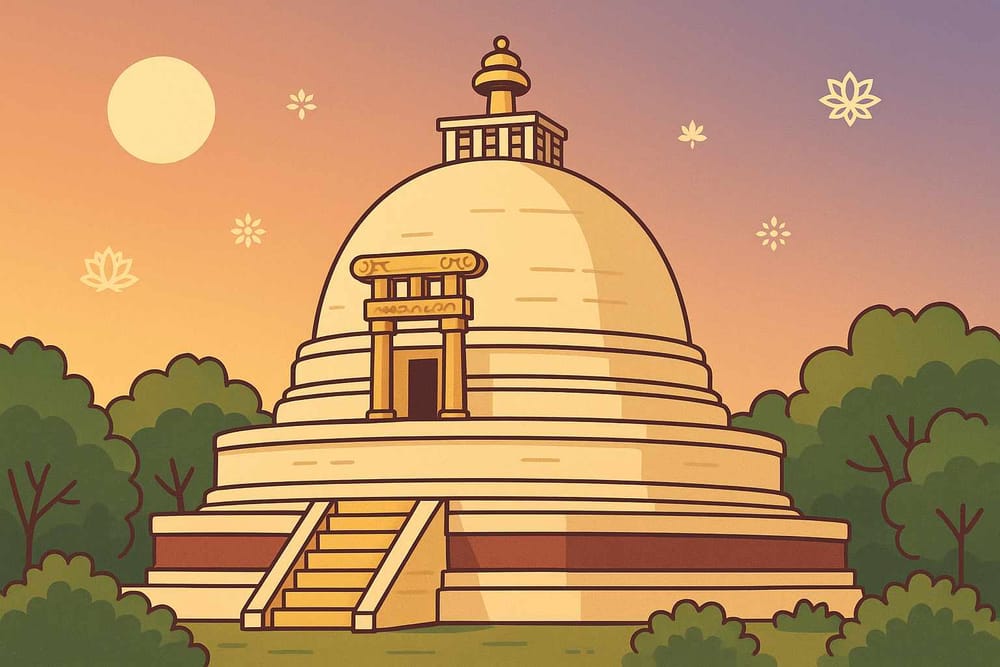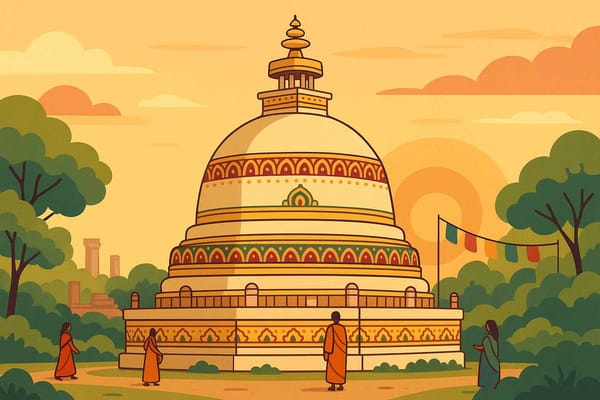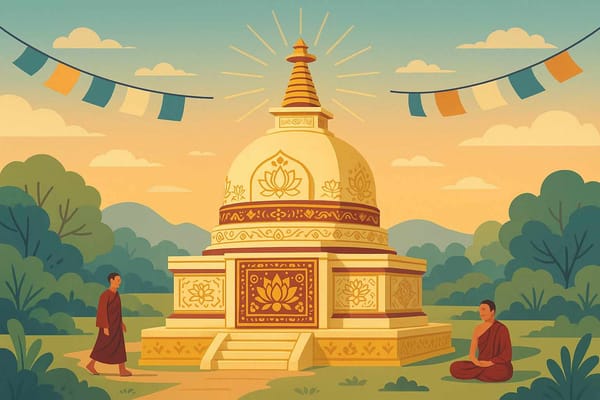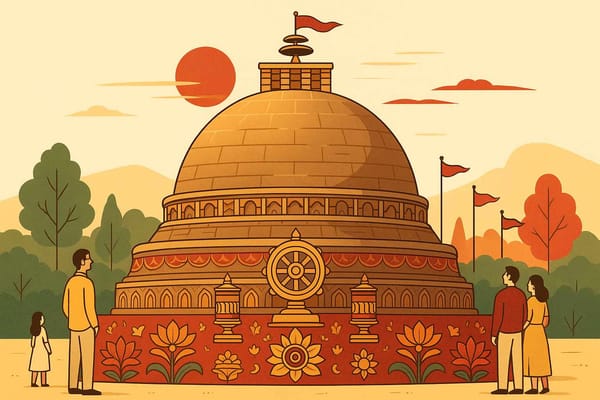
Dharmarajika Stupa- History Reveals Significance
Have you ever thought about how some stories are so powerful they refuse to be confined by maps or borders? They travel through time, carried in the hearts of generations. One such story is that of the Dharmarajika Stupa, a monumental echo of faith that stands not in India, but in Taxila, Pakistan. Though a political line may separate us from its physical presence, its spirit is deeply woven into the fabric of our shared Indic heritage.
It’s a place that pulls you back in time, to an era of great kings and even greater spiritual awakenings. Let's take a journey together, not with our feet, but with our hearts, to understand this sacred marvel.
From a 'Righteous King' to a 'Scarred Hill': The Story of its Name
Every great monument has a story, and the Dharmarajika Stupa has several, starting with its very name. It is believed to have been built by the great Mauryan Emperor Ashoka in the 3rd century BCE. After the heart-wrenching Kalinga war, Ashoka embraced the path of Dharma, earning him the title 'Dharmaraja' or the 'Righteous King'. He built this stupa as an act of profound devotion, a home for the sacred relics of the Buddha himself. The name 'Dharmarajika' is a beautiful tribute to this legacy—a monument from the King of Dharma.
But time has given it another name, one that speaks of its resilience: Chir Tope, or the "Scarred Hill." This name hints at the centuries of challenges it has faced, from invasions to the simple passage of time, yet it stands proud, a testament to the enduring power of faith.
Why is this Ancient Stupa So Profoundly Sacred?
Imagine a place so holy that it was chosen to house a part of the Buddha's essence. That is the true significance of the Dharmarajika Stupa. Buddhist tradition tells us that after the Buddha's Parinirvana, his ashes were distributed among his followers. These relics were then enshrined in stupas across the land, transforming them into powerful centres of worship. The Dharmarajika Stupa was one of the most important of these, a place where devotees could feel a direct connection to the Enlightened One.
For centuries, it was a major pilgrimage site. You can almost hear the faint chants of monks and the soft footsteps of pilgrims who travelled from far and wide, seeking blessings and peace. Many still believe that a visit to this sacred ground, even in spirit, brings good fortune and inner calm.
A Monument Built and Rebuilt Through Time
The journey of the stupa’s structure is as fascinating as its spiritual one. It didn't begin as the grand stone monument we see in ruins today. It started with a core of humble mud-bricks, built with devotion by Ashoka's command. Later, during the Kushan period, it was lovingly expanded and encased in stone, growing in size and splendour. Rulers from different dynasties, like the Indo-Scythians and Gandharans, added their own touch, restoring and beautifying it.
One of the key questions people have is whether the stupa is still fully intact. Sadly, it is not. Over the centuries, it suffered damage, and most notably, in 1794, much of it was dismantled for building materials. Yet, what remains tells a powerful story of survival. It’s a beautiful, poignant reminder that even when things are broken, their spirit can remain whole.
More Than Just Bricks and Mortar: A Treasure for History Lovers
When archaeologists began excavations here in the early 1900s, they uncovered a world frozen in time. This wasn't just a single structure; it was the heart of a vast monastic complex. The finds were breathtaking—a stunning green marble reliquary, colossal statues of Bodhisattvas from the Kushan era, and a serene Gupta-era Buddha sculpture. These aren't just artefacts; they are storytellers, revealing the rich artistic and spiritual life of ancient Gandhara.
The architectural style itself, with its three-tiered structure and decorative carvings, offers deep insight into early Buddhist practices. It's a living history book written in stone. This deep connection between architecture and spirituality is a hallmark of our subcontinent's heritage. Just as the historical sites in Udaipur tell tales of royal grandeur and devotion, the ruins of Dharmarajika narrate the story of Buddhism's golden age.
Preserving Our Shared Heritage in the Digital Age
Stories like that of the Dharmarajika Stupa are our collective treasures. They connect us to our roots and remind us of the timeless wisdom our ancestors possessed. In today's fast-paced world, it's more important than ever to keep these flames of heritage burning bright for our children and future generations.
At Bhaktilipi, this is our humble mission. We are a digital space dedicated to preserving, reimagining, and sharing timeless devotional literature and stories. We believe that the wisdom of our traditions, whether found in the tales of Vaishnava saints at the splendid Jagdish Temple or in the serene silence of a Buddhist stupa, holds the power to inspire and connect us all.
Explore more such cultural treasures with us and stay connected to your roots. Follow our journey and be a part of our community:
- Stay connected on Facebook for daily inspiration and stories.
- Follow us on Instagram for beautiful visuals and short, insightful snippets from our heritage.
- Subscribe to our YouTube channel for engaging videos that bring ancient wisdom to life.
The Enduring Message of Dharmarajika
The Dharmarajika Stupa is more than a ruin; it is a beacon of peace. Its very existence is a reminder of a king who chose compassion over conflict and a teacher who showed humanity the path to liberation from suffering. Though scarred by time and history, its spiritual energy remains undiminished.
It teaches us that true heritage isn't just about magnificent structures but about the values they represent—peace, compassion, and the unwavering quest for truth. It is a legacy that belongs to all of us, a timeless whisper of wisdom from the heart of ancient India.
A passionate group of people dedicated to preserving India's knowledge of Dharma, Karma, and Bhakti for ourselves and the world 🙏.
Comments
Related in

Exploring the Ancient Dharmarajika Stupa- History Unfolds
Imagine a place where the very air seems to hold the echoes of ancient chants, a place where stones, weathered by centuries, tell a story of unwavering faith. This isn't just a fantasy; it's the living legacy of the Dharmarajika Stupa in Taxila, Pakistan. This isn&

Dharmarajika Stupa- History Reveals Significance
Some places in the world don't just exist in the present; they carry the whispers of centuries within their very stones. Imagine standing on ground that witnessed a great emperor's change of heart, a place where the message of peace was shaped into a magnificent structure.

Dharmarajika Stupa: Journey Through History
Have you ever stood in a place so ancient that you can almost hear the whispers of history in the wind? A place where the stones themselves seem to tell stories of emperors, monks, and seekers from centuries ago. One such place is the magnificent Dharmarajika Stupa, nestled near Taxila
